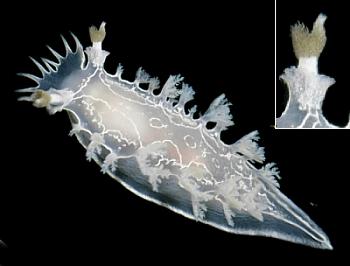
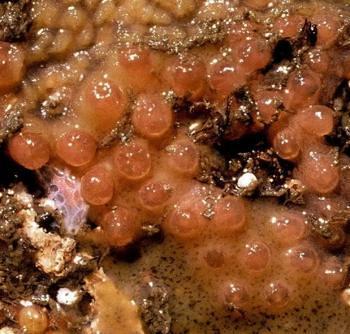
Tritonia festiva
(Stearns, 1873)
Order: NUDIBRANCHIA
Suborder: DENDRONOTINA
Family: Tritoniidae
DISTRIBUTION
Known from south-central Alaska to northern Baja California and is also known from Japan.
PHOTO
UPPER: 25 mm long animal, Cape Arago, Oregon, USA.
LOWER: Juvenile Tritonia festiva next to contracted polyps of Cryptophyton goddardi Williams 2000 on the underside of an intertidal boulder at Cape Arago. The polyps are 3 mm in diameter. Photos: Jeff Goddard.
Nudibranchs of the family Tritoniidae prey on soft corals, gorgonians and other octocorallian anthozoans. Their digitate frontal veil is extremely sensitive and used for locating expanded polyps of their prey and for carefully positioning the mouth over these in preparation for a surprise attack. The ensuing attack is swift, as the nudibranch lunges into the colony and bites off polyps before they can contract into the protective cover of the spiculate colony mass. Tritonia festiva will not attack contracted colonies, and severed polyps are eventually regenerated by all but the smallest octocoral colonies.
Tritonia festiva is an opportunistic predator and feeds on every octocoral known intertidally from its North American range. These include the soft corals Alcyonium rudyi and Gersemia rubiformis, the mat-forming and recently described stoloniferan Cryptophyton goddardi (=Clavularia sp. of Ricketts et al., 1985), and an undescribed stoloniferan in southern California (McDonald & Nybakken, 1978; Jaeckle, 1984; Goddard, 1984, 1998, unpublished observations). Subtidally, Tritonia festiva has been reported feeding on the sea pen Ptilosarcus gurneyi and the gorgonian Lophogorgia chilensis (Gomez, 1973; Birkeland, 1974). The gill tufts of Tritonia festiva closely resemble the expanded polyps of Alcyonium rudyi, and when viewed from an oblique angle the nudibranch is quite cryptic among the colonies of this abundant northeastern Pacific species. [see separate message about feeding on the soft coral Alcyonium rudyi].
Tritonia festiva can escape from predatory seastars like Pycnopodia helianthoides and Solaster dawsoni by swimming off the substratum (Birkeland, 1974; T. A. Wayne, personal communication). The egg mass of Tritonia festiva is a thin delicate rosette. Its egg capsules, unlike those of most nudibranchs, are not embedded in a jelly matrix but float free inside the fluid filled cord. Planktotrophic veliger larvae hatch after 12 days at 14 to 17 degrees C (Goddard, 1984).
Tritonia festiva ranges from south-central Alaska to northern Baja California and is also known from Japan (McDonald, 1983). Intertidally it grows to about 35 mm in length (personal observations).
-
Birkeland, C. (1974) Interactions between a sea pen and seven of its predators. Ecological Monographs, 44: 211-232.
-
Goddard, J. H. R. 1(984) The opisthobranchs of Cape Arago, Oregon, with notes on their biology and a summary of benthic opisthobranchs known from Oregon. The Veliger, 27(2): 143-163.
-
Goddard, J. H. R. (1998) A summary of the prey of nudibranch molluscs from Cape Arago, Oregon. Opisthobranch Newsletter, 24: 11-14.
-
Gomez, E. D. (1973) Observations on feeding and prey specificity of Tritonia festiva (Stearns) with comments on other tritoniids (Mollusca: Opisthobranchia). The Veliger, 16: 163-165.
-
Jaeckle, W. B. (1984) The opisthobranch mollusks of Humboldt County, California. The Veliger, 26:207-213.
-
Mauzey, K. P., C. Birkeland & P. K. Dayton. (1968) Feeding behavior of asteroids and escape responses of their prey in the Puget Sound region. Ecology, 49:603-619.
-
McDonald, G. R. (1983) A review of the nudibranchs of the California coast. Malacologia, 24: 114-276.
-
McDonald, G. R. & J. W. Nybakken. (1978) Additional notes on the food of some California nudibranchs with a summary of known food habits of California species. The Veliger, 21(1):110-119.
-
Ricketts, E. F., J. S. Calvin & J. W. Hedgpeth. (1985) Between Pacific Tides. 5th ed. Revised by D. W. Phillips. Stanford University Press: Stanford, California.
-
Williams, G. C. (2000) A new genus and species of stoloniferous octocoral (Anthozoa: Clavulariidae) from the Pacific coast of North America. Zoologische Mededelingen, 73: 333-343.
Goddard, J., 2000 (October 2) Tritonia festiva (Stearns, 1873). [In] Sea Slug Forum. Australian Museum, Sydney. Available from http://www.seaslugforum.net/find/tritfest
Related messages
Re: Tritonia festiva from southern California
January 8, 2007
From: Jim Lyle
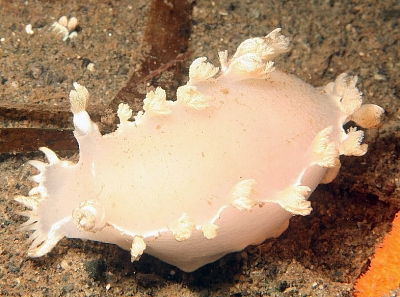
Concerning message #19068:
Dr. Rudman,
I believe Graham's nudibranch is Tritona diomedea.
Best,
Jim Lyle
jlyle@adelphia.net
Lyle, J.L., 2007 (Jan 8) Re: Tritonia festiva from southern California. [Message in] Sea Slug Forum. Australian Museum, Sydney. Available from http://www.seaslugforum.net/find/19106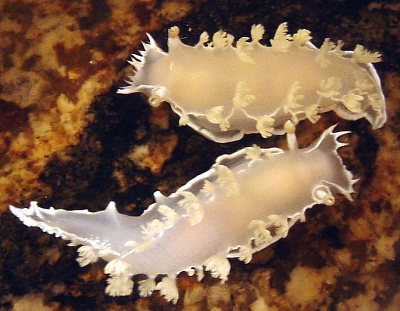
Hi Jim,
Thanks for the note but Graham's critter is absolutely Tritonia festiva. The reticulated pattern, although faded and damaged separates it from T. diomedea.
We need to keep in mind that tritonids, like other groups, are highly variable in color. Many are actually affected by the most recent prey fed upon.
Coincidentally I have just received two huge specimens from Puget Sound, Washington State. These 100 mm specimens have no reticulating pattern at all, but are in fact T. festiva. The upper photo was taken by Greg Jensen, who collected the specimens and contacted me. The lower photo, taken by yours truly is a kitchen counter shot, but shows the characteristic frontal veil and gill tufts.
PHOTOS: Rich Passage off Ft.Warden State Park, Puget Sound, Washington, USA. 30 feet on sand bottom, with sea pens. Specimen 100 mm in length. Upper photo: Greg Jensen. Lower photo:Dave Behrens.
The only published photo I am aware of, of this color morph is in Lamb & Hanby (2005). A specimen identical to Gregs shown here can be found on page 261 of this terrific field guide.
-
Lamb, Andy & Bernard. P. Handy. (2005). Marine Life of the Pacific Northwest - A photographic encyclopedia of invertebrates, seaweeds and selected fishes. Harbour Publishing, British Columbia.
Best wishes,
Dave Behrens
Tritonia festiva from southern California
December 30, 2006
From: Graham Short
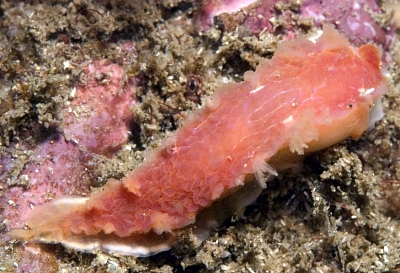
I found this nudibranch on a large rock in 7 m in a high surge area off of Santa Cruz Island. It blended very well with the rock, and I'm unable to identify it as I can't find it in the Californa nudibranch identification books or websites.
Locality: Santa Cruz Island, 7m, California, USA, East Pacific Ocean, 11 November 2006, Rocky reef. Length: 1.5 inches. Photographer: Graham Short .
Cheers,
Graham Short
gashort@mac.com
Short, G.A., 2006 (Dec 30) Tritonia festiva from southern California. [Message in] Sea Slug Forum. Australian Museum, Sydney. Available from http://www.seaslugforum.net/find/19068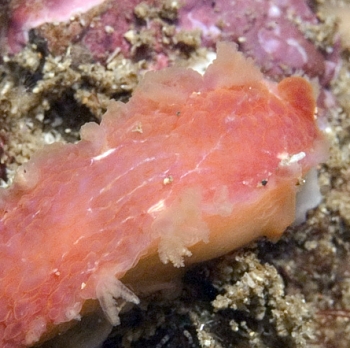
Dear Graham,
Looks to me like your specimen is a victim of that heavy surge area. It looks pretty battered. Looking closely at the close-up photo you can see that the tufts along the body margin are clearly those of a Tritonia, and the faintly visible white reticulated pattern on the dorsum, leads me to believe it is Tritonia festiva Bergh, 1894.
Tritonia festiva most common background color is white, but specimens of this species may vary to yellow and even burnt sienna. Your specimen leans towards this end.
Thanks for sharing this,
Dave Behrens
Food of Tritonia festiva
July 31, 2006
From: Dong Bum Koh
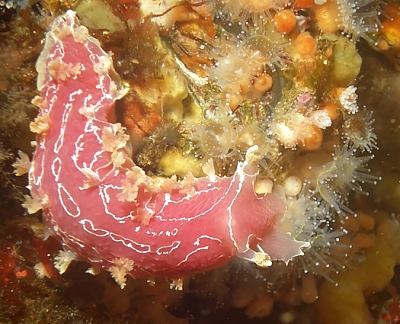
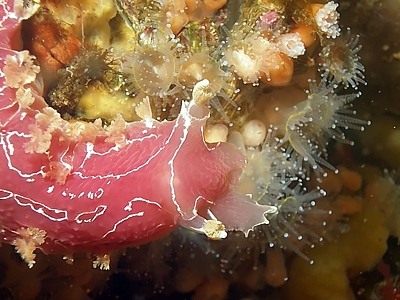
Dear Bill,
Concerning the foods of Tritonia festiva, the soft coral Gersemia rubiformis is known to be one of its main foods, and the photo in my previous message [#17010] shows that another soft coral, Bellonella rigida, is also eaten.
Here are photos of two more food items. Could you let me know your comments?
Locality: Ul Reung Island, [N 37°35' E 131°00']-15 m, Korea, East Sea, 16 July 2006, -. Length: Approx. 40 mm. Photographer: Im Sung Hwang.
Best regards,
Dong Bum Koh
drkoh@seasee.co.kr
Koh, D.B., 2006 (Jul 31) Food of Tritonia festiva. [Message in] Sea Slug Forum. Australian Museum, Sydney. Available from http://www.seaslugforum.net/find/17250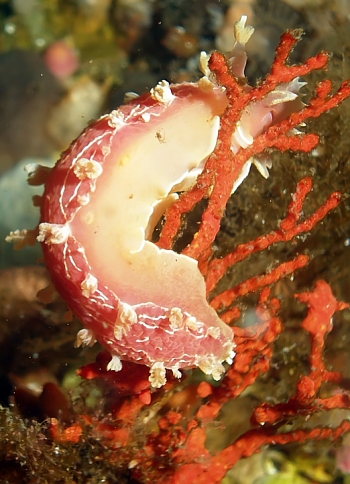
Dear Koh,
I am not an expert on cnidarians but the 'anemones' in the upper photo look as though they may be a jewel anemone [Order Corallimorpharia]. In Australia the common genus is Corynactis.
The red branching colony in your lower photo would appear to be a gorgonian soft coral. This nudibranch would appear to feed on a wide range of cnidarians including the octocorals (soft corals, gorgonians) and the pennatulacean sea pens.
Best wishes,
Bill Rudman
Nudibranchs from the Yellow Sea - Tritonia festiva
June 30, 2006
From: Dong Bum Koh
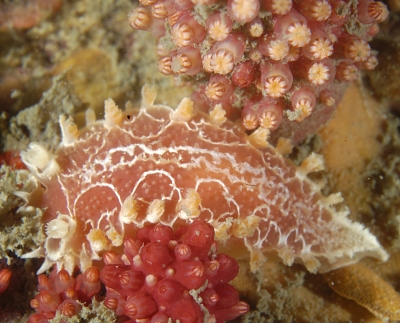
Dear Bill,
As I mentioned in my first message [#16960], sea slugs from the Yellow Sea (between China & Korea) are not well-known because poor visibility & very strong currents makes its bad for diving..
Here is another species photographed last weekend by a colleague of mine. It is Tritonia festiva
Locality: Gogunsan islands, [Diving site : E 126°4' N 35°8'] 10m, Korea, Yellow Sea, 18 June 2006, Length: unknown. Photographer: Sung Soon Choi.
Best regards.
Dong Bum Koh
drkoh@seasee.co.kr
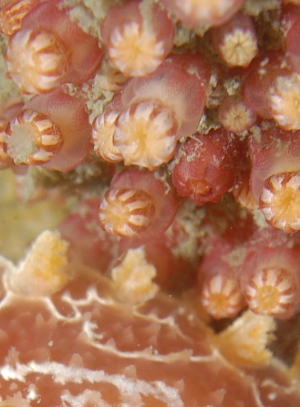
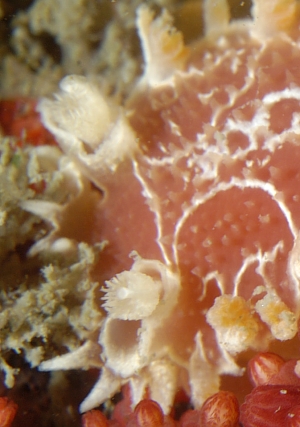
Dear Koh,
Thanks for this nice record of Tritonia festiva. A well-known member of the fauna of the Nth American west coast, it is also known from Japan and you have reported it from the south east coast of Korea, so it is nice to be able to include the Yellow Sea as well. I assume the soft-coral in the photo is its food. I have included close-ups to show the similarity in shape and size between the gills and rhinopores of the nudibranch and the soft-coral's polyps, probably another attempt at camouflage by the nudibranch. It would be interesting to know if the colour variation in this species, from this reddish or pinkish brown to translucent white, correlates with the colour of the soft-corals they are feeding on.
Best wishes,
Bill Rudman
Colour variation in Tritonia festiva
June 11, 2005
From: Dong Bum Koh
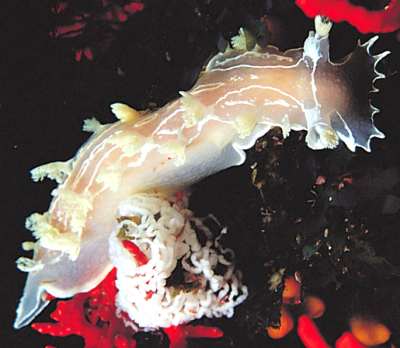
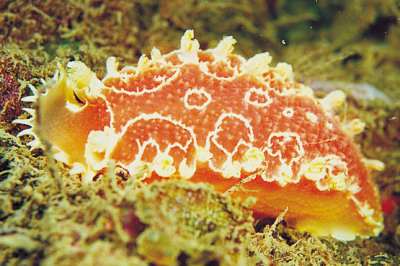
Dear Bill,
Here are some photos of what I think is Tritonia festiva from South Korea.
All photos were taken in east coast of Korean Peninsula.
Upper: Animal with eggs. Site: Yang yang,. Kang Won Province. 12 m depth..17 June 2000. Size : 28 mm in length. Photographer: Yu Woong Kim.
Others: Kang Won Province, South Korea. Photo Credit: Poong Deung Publishing company
Dong Bum Koh
drkoh@seasee.co.kr
Koh, D.B., 2005 (Jun 11) Colour variation in Tritonia festiva. [Message in] Sea Slug Forum. Australian Museum, Sydney. Available from http://www.seaslugforum.net/find/14021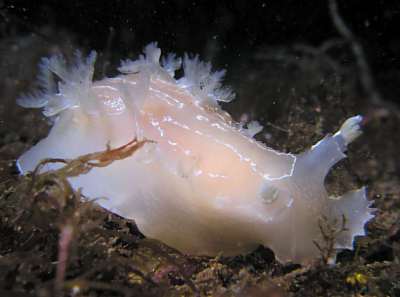
Dear Koh,
Thanks for these photos which show the extreme range in colour found in this species.
Best wishes,
Bill Rudman
Tritonia festiva from British Columbia
June 10, 2005
From: Marli Wakeling
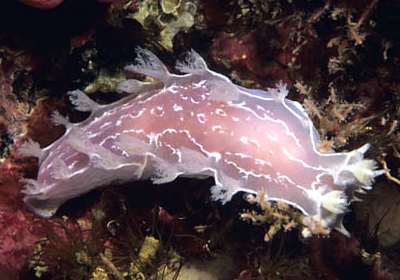
Hi Bill,
A rather interesting specimen of Tritonia festiva. The design on the back is really indistinct on these nudibranchs in this locale, as opposed to the diamond pattern usually seen. They are also pink as opposed to the usual white.
Locality: Plumper Rock, Broughton Archipelago, British Columbia, Canada,
Pacific Coast. Depth: 45 feet. Length: 50 mm. 21 May 2005. Rocky wall. Photographer: Marli Wakeling
Cheers,
Marli
scubamarli@excite.com
Wakeling, M, 2005 (Jun 10) Tritonia festiva from British Columbia. [Message in] Sea Slug Forum. Australian Museum, Sydney. Available from http://www.seaslugforum.net/find/13984Dear Marli,
Thanks for this. I assume the pink is the viscera showing through the translucent body wall. So if they are pinker than normal I suspect it has something to do with the colour of the soft-corals they are feeding on.
Best wishes,
Bill Rudman
Tritonia festiva from British Columbia
October 24, 2003
From: Bruce Wight
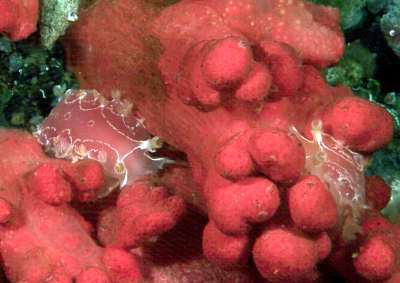
Dear Bill
Here are some photos of Tritonia festiva from our recent trip to British Columbia.
Johanna and I were up at the Northern end of Vancouver Island the first week of October diving around Port Hardy and Browning Pass, British Columbia. This was our first time diving in Canada.
We also photographed Tritonia festiva which like Tochuina tetraquetra appeared to be feeding on the Gersemia. These animals took on the pink color unlike the many I have seen in California which are milky white in color.
Take care,
Bruce Wight
bwproductions@earthlink.net
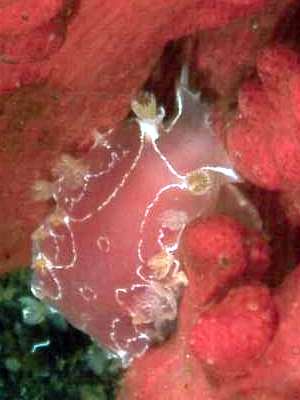
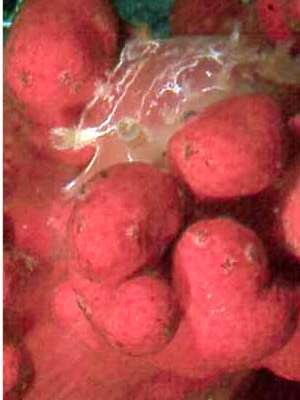
Thanks Bruce,
They certainly do seem to be feeding
Bill Rudman
Tritonia festiva from San Diego, California
September 18, 2003
From: Alan Shepard
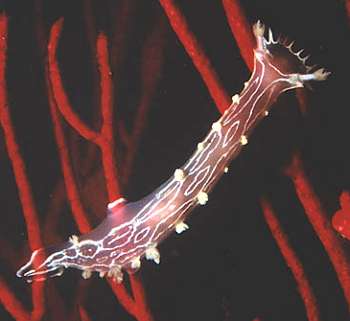
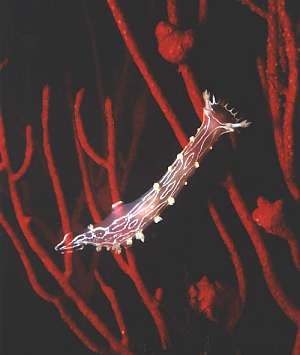
Bill –
I recently had the opportunity to dive in the waters off San Diego, California and was able to photograph a few of the local nudibranchs. Here is a shot taken on the wreck of the Ruby E., an artificial reef. This is Tritonia festiva and I believe the gorgonian it is crawling on is Lophogorgia chilensis, which is listed as one of its food choices.
The Ruby E. is covered in invertebrates, particularly Corynactis anemones. I observed quite a number of nudibranchs on the wreck. In addition to Tritonia festiva I found Flabellina iodinea, Polycera tricolor, Hermissenda crassicornis, Janolus barbarensis, Dialula sandiegensis and Anisodoris nobilis.
This particular Tritonia festiva seemed to be larger than the maximum lengths I have read about. Behrens states a usual length of 20mm. This one was approximately double that but as you can see it was stretching itself across the gorgonian. The approximate depth of this find was 25m and the waters were a cool 10c.
Best wishes,
Alan Shepard
Tolland, CT, USA
alan.chepard@snet.net
Shepard, A., 2003 (Sep 18) Tritonia festiva from San Diego, California. [Message in] Sea Slug Forum. Australian Museum, Sydney. Available from http://www.seaslugforum.net/find/10987Thanks Alan,
I guess you will have noticed that the west coast fauna is rather different from that on the east coast
Best wishes
Bill Rudman
Tritonia festiva feeding on sea pens
July 4, 2003
From: Paul and Lily Sim
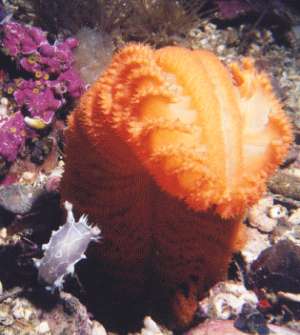
Hello Bill.
My wife Lily and I found this interesting scene playing out before us on the last dive of a trip to the west coast here in BC, Canada. At the time we did not know what to make of it but it was explained later that the sea pen here is bending over trying to fend off the Tritonia festiva which in turn has reared up to deliver its reply. We did not have the air to stick around and see who won. The first two shots are with a Bonica Multi (taken by Lily) and the third I took using a Nikonos V with a close-up-kit. Love your website!
Chup Point, Barclay Sound, British Columbia, Canada, Depth: 55 feet., Temp: 50 Farenheit.
Sandy gravel bed on a large pinacle. April 6, 2003.
Paul and Lily Sim
plsim@shaw.ca
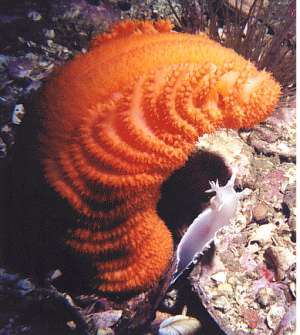
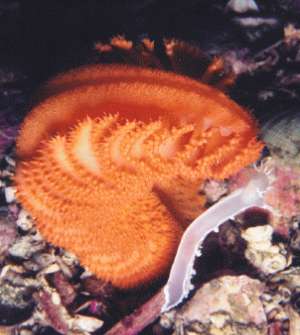
Dear Paul and Lily,
Thanks for these wonderful photos. As you'll see from Jeff Goddard's Fact Sheet, this species feeds on a wide variety of soft corals. However it is one thing to read about it, but quite to see photos. My understanding is that Tritonia festiva usually has to move fast when feeding so that the soft coral polyps it is eating don't retract before it has bitten off a piece. Perhaps with the sea pens, a quick bite helps it avoid being stung, as the sea pen 'colony' does not seem to be retracting.
Best wishes,
Bill Rudman
Tritonia festiva from Anacapa Island, California (1)
October 17, 2002
From: Bruce Wight
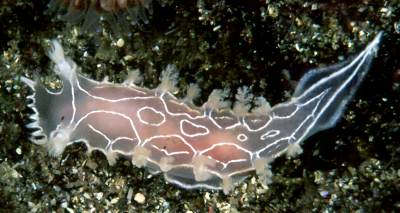
Hi Bill,
We just got back from a three day trip out to Anacapa and Santa Barbara Islands, California [September 2002]. Dive conditions were pretty bad with heavy surge and current in most of the areas we dove. There were a great many Tritonia festiva out on the South end of Anacapa in about 40-50 feet depth. Water temp is up to 64 degrees. Thought you might enjoy seeing some of the images.
Bruce Wight
bwproductions@earthlink.net
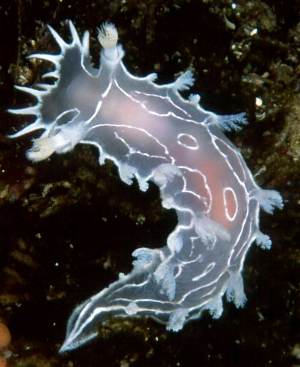
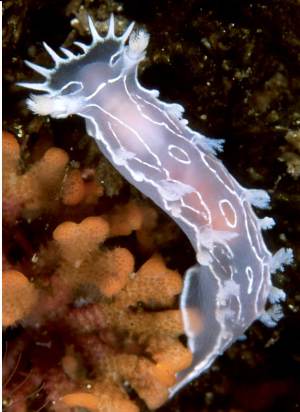
Thanks Bruce,
I have split your wonderful images into a number of messages.
best wishes,
Bill Rudman
Tritonia festiva from Anacapa Island, California (2)
October 17, 2002
From: Bruce Wight
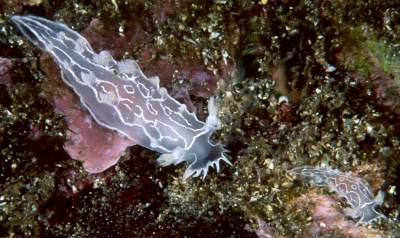
Dear Bill,
Here is a photo from out trip to Anacapa Island, California, showing an adult and juvenile Tritonia festiva. As with the other photos they were on the South end of Anacapa in about 40-50 feet depth. [September 2002].
Bruce Wight
bwproductions@earthlink.net
Wight, B., 2002 (Oct 17) Tritonia festiva from Anacapa Island, California (2). [Message in] Sea Slug Forum. Australian Museum, Sydney. Available from http://www.seaslugforum.net/find/8188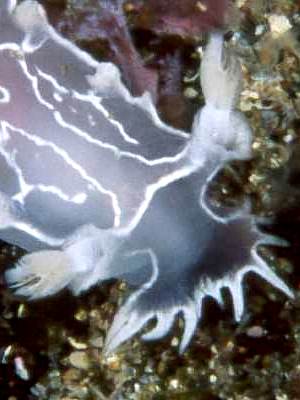
Thanks Bruce,
I have included a close-up of the adult's head, as it shows the shape of the head and rhinophores very well.
Best wishes,
Bill Rudman
Egg mass of Tritonia festiva
April 15, 2002
From: Jeff Goddard
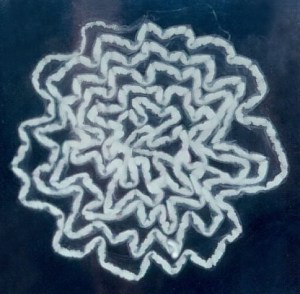
Hi Bill,
Here is the photo I promised you of the egg mass of Tritonia festiva. The egg masses are usually about 15 mm in total diameter, very thin, and laid close to their soft coral prey. This one was laid in captivity on the side of a glass jar.
Best,
Jeff Goddard
goddard@lifesci.ucsb.edu
Goddard, J., 2002 (Apr 15) Egg mass of Tritonia festiva. [Message in] Sea Slug Forum. Australian Museum, Sydney. Available from http://www.seaslugforum.net/find/6688Thanks Jeff,
Bill Rudman
Egg mass in photo of Tritonia festiva
March 31, 2002
From: Jeff Goddard
Hi Bill,
The egg mass in Marli Wakeling's photo of Tritonia festiva looks very much like those laid by the dendronotids, especially with those irregular convolutions, inflated appearance and the glistening shells of the embryonic veligers. The embryos of the dendronotids (as well as aeolids belonging to the family Tergipididae) develop egg-shaped, inflated shells which are larger than the spiral shells typical of other embryonic nudibranchs. As these shells develop, the egg mass cord swells considerably from its original diameter, and the shells are noticably shiny and iridescent.
It's a bit difficult to make out in the photo, but that may be a Dendronotus in the upper right. I will send you a photo of the egg mass of Tritonia festiva as soon as my laptop is back from the shop.
Best wishes,
Jeff Goddard
goddard@lifesci.ucsb.edu
Goddard, J., 2002 (Mar 31) Egg mass in photo of Tritonia festiva. [Message in] Sea Slug Forum. Australian Museum, Sydney. Available from http://www.seaslugforum.net/find/6638Thanks Jeff,
I think some nudibranchs deliberately go and hide after laying their egg-ribbons to mislead us into thinking someone else laid their eggs. I look forward to your photos of T. festiva's egg ribbon.
Bill Rudman
Tritonia festiva from British Columbia
March 26, 2002
From: Marli Wakeling
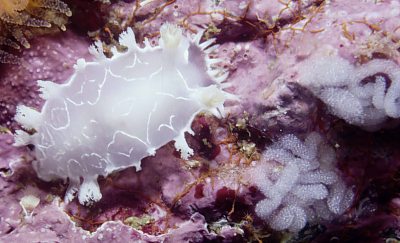
Hi Bill,
Here is a Tritonia festiva with an egg mass. This was found at 'Mo's Reef', at Barkley Sound, British Columbia. This is located on the West Coast of Vancouver Island.
PHOTO: Mo's Reef, Barkley Sound, British Columbia, Canada.
DEPTH: 35 feet
LENGTH: 9mm
DATE: May 13, 2001
PHOTO BY: Marli Wakeling
Marli
scubamarli@excite.com
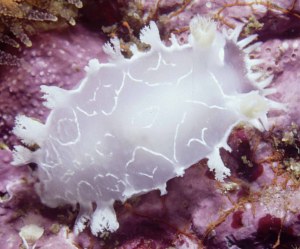
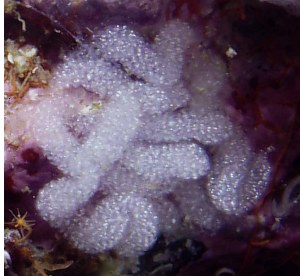
Note: See Jeff Goddard's message and photo concerning the identity of this egg mass.
Thanks Marli,
I see that Jeff Goddard in account of this species described the egg ribbon as a 'delicate rosette'. I wouldn't have described this egg ribbon as a 'delicate rosette'. Is this the usual egg ribbon?
Best wishes,
Bill Rudman
Tritonia festiva from Oregon
October 4, 2000
From: Jeff Goddard


Hi Bill,
Here are some photos and an account of the biology of Tritonia festiva for The Forum.
UPPER PHOTO: Tritonia festiva, 25 mm long, from Cape Arago, Oregon
LOWER PHOTO: Juvenile Tritonia festiva (right center) next to contracted polyps of Cryptophyton goddardi Williams, 2000 (center) on the underside of an intertidal boulder at Cape Arago. The polyps are 3 mm in diameter.
Best wishes,
Jeff
goddard@lifesci.ucsb.edu
Dear Jeff,
Thnks for the great photos of Tritonia festiva and one of the soft corals it feeds on, and for the information on Tritonia festiva. I have posted your photos of Tritonia festiva and its food, Alcyonium rudyi in a separate message.
Best wishes,
Bill Rudman
Feeding observations for Tritonia festiva
October 4, 2000
From: Jeff Goddard
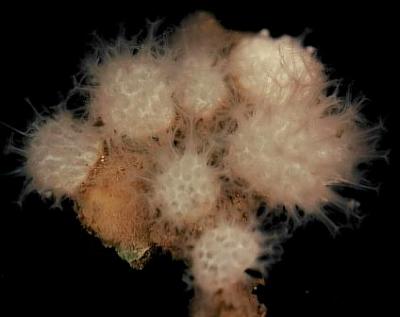
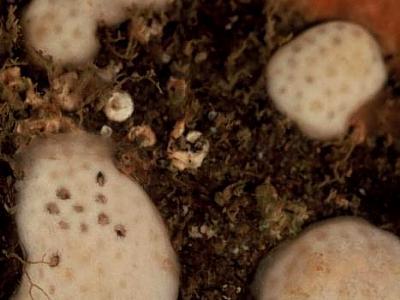
Dear Bill,
Here are two photos to illustrate the information in my earlier message, and at the Top of the page, about T. festiva feeding on the soft coral Alcyonium rudyi.
UPPER PHOTO: Alcyonium rudyi Verseveldt & van Ofwegen, 1992 from Cape Arago. Colonies of this species divide by fission to produce large aggregations of relatively small and evenly spaced colonies. The largest colony pictured here is 14 mm long.
LOWER PHOTO: Alcyonium rudyi immediately following an attack by Tritonia festiva. The holes in the lower left colony mark the position of polyps severed from the colony and ingested by the nudibranch.
Jeff Goddard
goddard@lifesci.ucsb.edu
Goddard, J., 2000 (Oct 4) Feeding observations for Tritonia festiva. [Message in] Sea Slug Forum. Australian Museum, Sydney. Available from http://www.seaslugforum.net/find/3112Thanks Jeff,
Bill Rudman.
